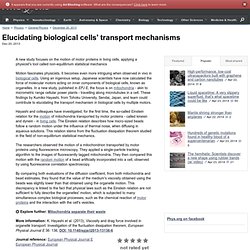

WEATHER in a TANK: Experiments & Observations. Read about the project in the following articles: "WEATHER IN A TANK”—Exploiting Laboratory Experiments in the Teaching of Meteorology, Oceanography, and Climate - BAMS (Nov 2009) The Effectiveness of Rotating Tank Experiments in Teaching Undergraduate Courses in Atmospheres, Oceans, and Climate Sciences - Journal of Geoscience Education (Feb, 2012) This is an NSF-funded project in which curricula materials that combine atmospheric data and laboratory fluid experiments are being developed in the teaching of meteorology, oceanography and climate at undergraduate level.

Continuity of volume flux - The WikiPremed MCAT Course. Courses: nanoHUB-U: Bioelectricity. The text for this course is “Neuroscience” by Purves, et al.

The text is available through the following link: This five-week short course aims to introduce students to bioelectricity using a unique, “bottom up” approach. (non-YouTube version) Fundamentals of bioelectricity of the mammalian nervous system. Passive and active forms of electric signaling in both intra and inter-cellular communication at the atomic, molecular, and engineered device level. Preview the lectures below, or join the course by clicking the yellow button on the right and entering your nanoHUB login information! Week 1: Introduction to the Nervous System by Pedro Irazoqui Week 2: Chemical Basis of Electrical Signals by Pedro Irazoqui Week 3: Models of Biological Conductors by Pedro Irazoqui.
Video: About this course Introduction to the MOOC: Water Treatment About this course. Skip to this view's content Please enter your e-mail address below, and we will e-mail instructions for setting a new password.

Help Have general questions about edX? You can find lots of helpful information in the edX FAQ. Have a question about something specific? Report a problem Make a suggestion Ask a question Please note: The edX support team is English speaking. Thank you for your inquiry or feedback. We're Sorry, edX accounts are unavailable currently. What percentage of your brain do you use? - Richard E. Cytowic. Structural biology: More than a crystallographer : Naturejobs. Interview: Prof. Kimberly Hamad-Schifferli. Eye Cells Made with Ink-Jet Printer. Ink-jet printing technology could be a way to build new tissue meant to restore vision to people suffering from common forms of blindness due to retinal degeneration.

Researchers at the University of Cambridge used a standard ink-jet printer to form layers of two types of cells taken from the retinas of rats, and showed that the process did not compromise the cells’ health or ability to survive and grow in culture. Ink-jet printing has been used to deposit cells before, but this is the first time cells from an adult animal’s central nervous system have been printed. The group hopes to develop the technology into a tool for generating new tissues that can be grown outside the eye and implanted in patients with retinal damage.
Alternatively, the technique could potentially be used to insert cells directly into damaged retinas during ocular surgery, says Keith Martin, a professor of ophthalmology at the University of Cambridge, who led the research. Drew Berry: Animations of unseeable biology. Indian scientists fight cancer with plant molecules. What do tea, turmeric and broccoli have in common?

A lot, when it comes to an arsenal of certain chemicals found in them, called phytochemicals, that can be harnessed to combat cancer therapy side-effects in synergy with conventional anti-cancer drugs. Chemotherapy is fraught with side-effects. Now Indian scientists have shown how certain naturally-occurring plant chemicals when used in combination with routine cancer drugs can actually lower the dosage of the medication, thereby minimising the after-effects.
Moreover, phytochemicals (plant chemicals) may increase the efficiency of the drugs, said Madhumita Roy, head of the Environmental Carcinogenesis and Toxicology Department at Chittaranjan National Cancer Institute (CNCI) here, who led the study. PHYS102x: Electricity & Magnetism from EdX. Basic Physics from Open2Study. PHYS102x: Electricity & Magnetism from EdX. How Things Work 1 from Coursera. Introductory Physics I with Laboratory from Coursera. Tokyo's innovative solution to keep old skyscrapers from toppling during earthquakes. Elucidating biological cells' transport mechanisms. A new study focuses on the motion of motor proteins in living cells, applying a physicist's tool called non-equilibrium statistical mechanics Motion fascinates physicists.

It becomes even more intriguing when observed in vivo in biological cells. Using an ingenious setup, Japanese scientists have now calculated the force of molecular motors acting on inner components of biological cells, known as organelles. In a new study, published in EPJ E, the focus is on mitochondria - akin to micrometric range cellular power plants - travelling along microtubules in a cell. These findings by Kumiko Hayashi, from Tohoku University, Sendai, Japan, and team could contribute to elucidating the transport mechanism in biological cells by multiple motors.
Hayashi and colleagues have investigated, for the first time, the so-called Einstein relation for the motion of mitochondria transported by motor proteins - called kinesin and dynein - in living cells. Explore further: Mitochondria separate their waste. Www3.nd.edu/~nismec/articles/framework-science standards.
Fluid Mechanics II video lectures,tutorials,online watch and free download.